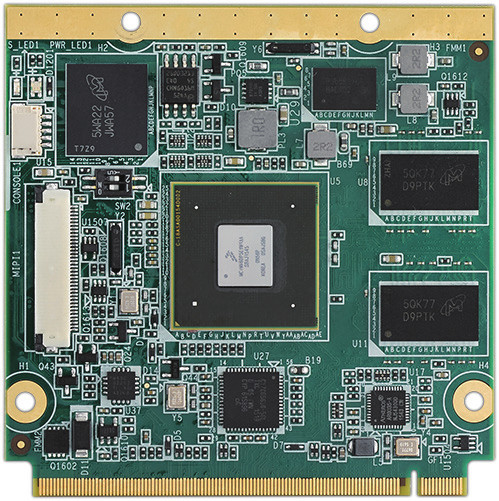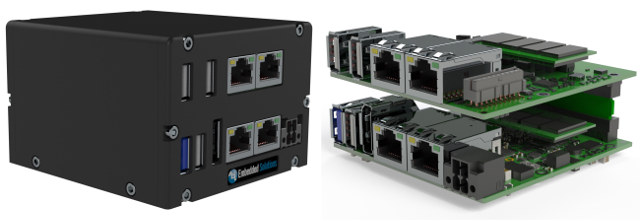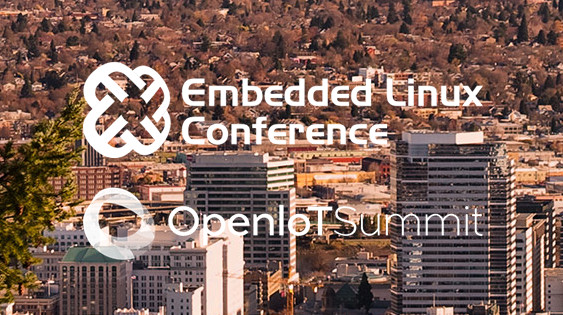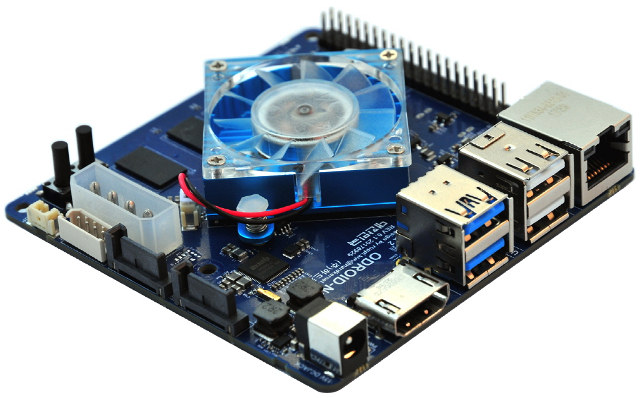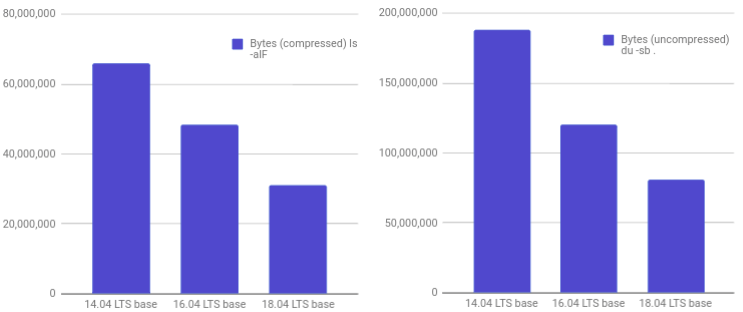Many solutions based on NXP i.MX8 processors are likely to be announced during Embedded World 2018 next week. We’ve already seen several NXP i.MX 8M Cortex A53 based modules such as Variscite DART-MX8M or Compulab CL-SOM-IMX8 systems-on-module, and more are coming. One of those will be Advantech ROM-7720 computer-on-module (CoM) featuring the top of the line NXP i.MX 8 QuadMax Cortex A72/A53 processor and following QSeven 2.1 specifications / form factor. Advantech ROM-7720 CoM specifications: SoC – NXP i.MX 8QuadMax processor with 2x Cortex A72 cores @ up to 1.6GHz, 4x Cortex A53 cores, 2x Cortex-M4F real-time cores, a HiFi 4 DSP, and 2x Vivante GC7000XSVX GPUs System Memory – 2GB LPDDR4 @ 1600 MHz (optional 4GB RAM) Storage – 8 GB eMMC Flash for OS, 64 MB Quad SPI Flash for boot loader Video Output / Display I/F 2x 24-bit LVDS, 1366 x 768 for 1ch; 1920 x 1080 […]
ADL Embedded Solutions ADLEPC-1520 Atom based Industrial Mini PC Supports Stackable I/O Expansion
ADL Embedded Solutions has recently announced ADLEPC-1520 embedded mini PC powered by a dual or quad core Intel Atom Bay Trail-I processor, supporting wide temperature range, and long term 15 years availability for industrial applications and environments. The computer also includes an expansion header with PCIe, SATA, USB, SM-Bus and DisplayPort interfaces, that allows for standard or custom expansion board stackable on top of the main board. ADLEPC-1520 specifications for the main board (ADLE3800SEC): SoC (one or the other) Intel Atom E3845 quad core Bay Trail-I processor @ up to 1.91GHz, with 2MB cache, 10W TDP Intel Atom E3827 dual core Bay Trail-I processor @ up to 1.75 GHz, with 1MB cache, 8W TDP System Memory – Up to 4GB soldered down Storage – 2x M.2 Key B 2242 SATA II SSD slots Video Output – 1x DisplayPort Connectivity – Dual Gigabit Ethernet USB – 1x USB 2.0, 1x USB […]
Embedded Linux Conference & IoT Summit 2018 Schedule
The Embedded Linux Conference 2018 and the OpenIoT Summit 2018 will jointly take place next month, on March 12 – 14, 2018 in Portland, Oregon, USA. The former is a “vendor-neutral technical conference for companies and developers using Linux in embedded products”, while the latter is a “technical conference for the developers and architects working on industrial IoT”. The Linux Foundation has already published the schedule, and it’s always useful to learn what will be discussed about even for people who won’t attend. With that in mind, here’s my own virtual schedule with some of the talks I find interesting / relevant to this blog. Monday, March 12 10:50 – 11:40 – Progress in the Embedded GPU Ecosystem by Robert Foss, Collabora Ltd. Ten years ago no one would have expected the embedded GPU ecosystem in Linux to be what it is now. Today, a large number of GPUs have […]
Monitor Network Traffic per Process with Nethogs
Yesterday I wrote about using 3G on Raspberry Pi board, and one of the commenter mentioned higher traffic than expected when connecting to 3G to just send a few bytes before disconnecting. One of the reasons are the extra data needed if you transmit data over a secure connection, for example establishing a PPP connection, connect to the board over SSH, and disconnect, results in the transmission & reception of a few kilobytes on my board:
|
1 2 |
Connect time 1.9 minutes. Sent 5815 bytes, received 6972 bytes. |
But if you get much more traffic than that, you may want to investigate if another package may transfer data when it detects the connection is up. To analyze traffic, tcpdump and Wireshark are good options, especially if you want to look into the packets data, however such tools do not tell you which process is sending or receiving the data. So I searched whether I could find a program that would do […]
Open Source Software Releases – VLC 3.0 and Android-x86 7.1-r1
Two completely unrelated open source projects have released a stable version of their software this week, but instead of writing a post for each I’ll write about them in a single post. VLC 3.0 Vetinari VLC developers have just released version 3.0 – codenamed Vetinari – of the popular media player with new features such as ChromeCast support, and 8K video playback. Other highlights from the release include: Hardware decoding enabled by default to get 4K and 8K playback 10-bit and HDR support (only on Windows 10 Fall Creators Update for now) 360 video and 3D audio, up to Ambisoncics 3rd order Allows audio passthrough for HD audio codecs Can play Blu-Ray Java menus: BD-J Browsing of local network drives and NAS VLC 3.0 is also the first major version to be released for all platforms at the same time, and you can download VLC 3.0 for Windows, Mac OS […]
Hardkernel Unveils ODROID-N1 Board with Rockchip RK3399 Processor, 4GB RAM, Dual SATA, and More
It’s official, there’s a bubble of Rockchip RK3399 boards announcements or launches in early 2018. After AAEON RICO-3399, Orange Pi RK3399, and Pine64 RockPro64, which add to 96Boards compliant Rock960 announced a couple a months ago, and which may launch in Q1 2018, Hardkernel has now announced they’ve been working on ODROID-N1 board. ODROID-N1 board specifications: SoC – Rockchip RK3399 hexa-core processor with a dual-core Arm Cortex-A72 @ 2GHz, a quad-core Arm Cortex-A53 @ 1.5Ghz, and a Mali-T860MP4 GPU that supports OpenGL ES1.1/2.0/3.0, OpenCL 1.2 System Memory 4Gbyte DDR3-1866 RAM, Dual channel interface for 64bit data bus width Storage – eMMC 5.0 (HS400) flash storage, UHS capable micro-SD slot., 2x SATA3 ports using, native SATA implementation via PCIe-gen2 to SATA3 interface Video Output – HDMI 2.0 for 4K display Connectivity – Gigabit Ethernet port USB – 2x USB 3.0 host ports, 2x USB 2.0 host port. Expansion – 40-Pin GPIO […]
Vorke V1 Plus Celeron J3455 Mini PC Review with Windows and Ubuntu
Most Intel based mini PCs use processors classified as ‘Mobile’ as these have lower thermal design power (TDP) ratings which is the maximum amount of heat generated by the processor: However, the new Vorke V1 Plus has incorporated a ‘Desktop’ processor namely the Intel Celeron J3455. On paper this processor looks like it should perform similar to the Intel Pentium N4200 processor but with a tradeoff between being a cheaper processor to purchase but more expensive to run due to the increased power requirements. Geekbuying provided a Vorke V1 Plus for review so let’s start by taking a look at the physical characteristics. The device comes in a plain box and was supplied with the ‘right AC Adapter’ for my country. The first observation is that it is quite a large device. At just over 6” square (153mm) and nearly 1.5” tall (38mm) it is the biggest mini PC I’ve […]
Ubuntu 18.04 LTS Minimal Image Gets Even Smaller (30MB Compressed)
Sometimes you want to get the smallest image you can get, either because your storage device has limited capacity, you may want a faster boot, oe because you can. In the past, I’ve covered minimal firmware images for Raspberry Pi using Raspbian or the Yocto Project, as well as SliTaz or more recently a minimal Ubuntu 16.04 for ODROID C2/C1+ boards. Minimal images are also popular for containers like docker or LXD. Canonical has released Ubuntu minimal images for several years, and Dustin Kirklan blogged about Ubuntu 18.04 LTS mini images a few days ago, showing the good progress made over Ubuntu 14.04 and 18.04 “Bionic Beaver”, and asking for feedback. The charts above shows the minimal image went from around 62.78 MB (compressed) and 179.67 MB (uncompressed) for Ubuntu 14.04 LTS down to 29.65 MB (compressed) and 77.5 MB (uncompressed). That’s the number of AMD64 images, but ARM64 Ubuntu […]


